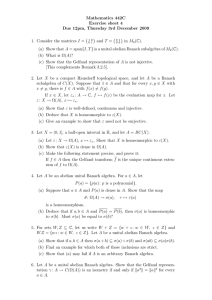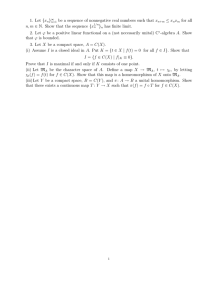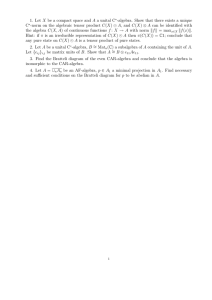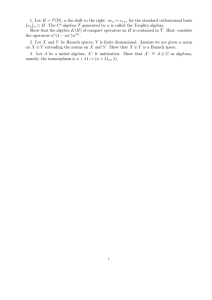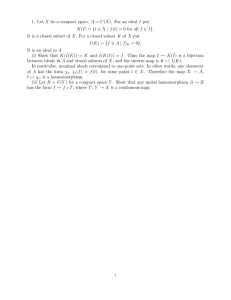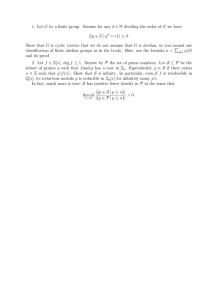Mathematics 442C Suggested solutions to exercise sheet 4
advertisement
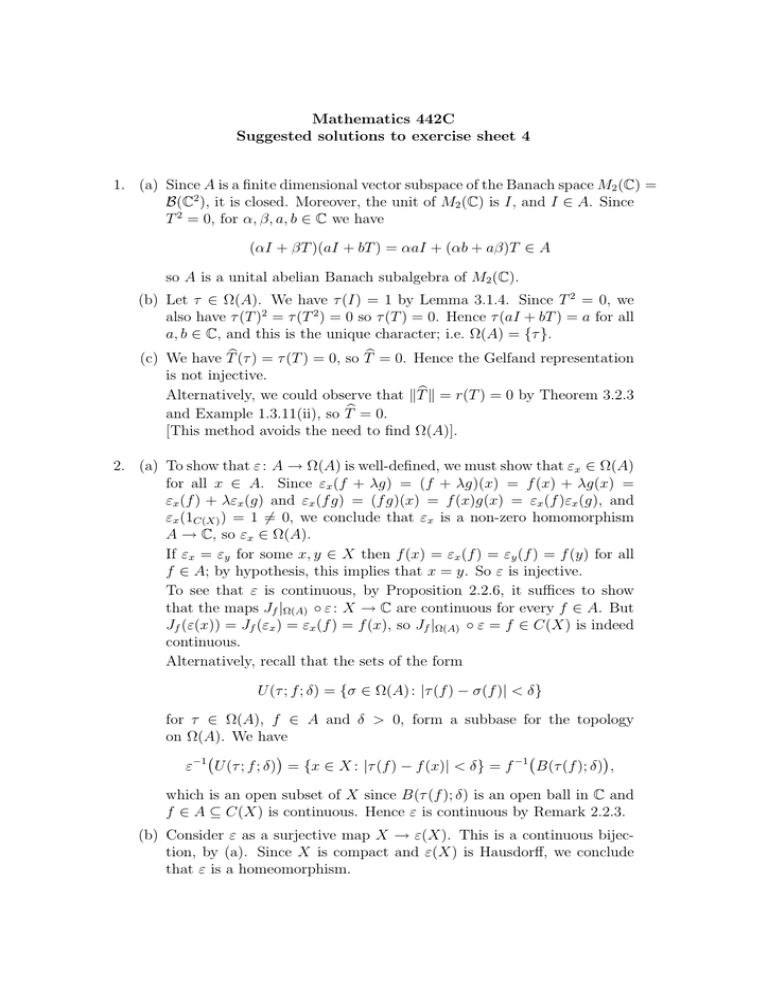
Mathematics 442C
Suggested solutions to exercise sheet 4
1. (a) Since A is a finite dimensional vector subspace of the Banach space M2 (C) =
B(C2 ), it is closed. Moreover, the unit of M2 (C) is I, and I ∈ A. Since
T 2 = 0, for α, β, a, b ∈ C we have
(αI + βT )(aI + bT ) = αaI + (αb + aβ)T ∈ A
so A is a unital abelian Banach subalgebra of M2 (C).
(b) Let τ ∈ Ω(A). We have τ (I) = 1 by Lemma 3.1.4. Since T 2 = 0, we
also have τ (T )2 = τ (T 2 ) = 0 so τ (T ) = 0. Hence τ (aI + bT ) = a for all
a, b ∈ C, and this is the unique character; i.e. Ω(A) = {τ }.
(c) We have Tb(τ ) = τ (T ) = 0, so Tb = 0. Hence the Gelfand representation
is not injective.
Alternatively, we could observe that kTbk = r(T ) = 0 by Theorem 3.2.3
and Example 1.3.11(ii), so Tb = 0.
[This method avoids the need to find Ω(A)].
2. (a) To show that ε : A → Ω(A) is well-defined, we must show that εx ∈ Ω(A)
for all x ∈ A. Since εx (f + λg) = (f + λg)(x) = f (x) + λg(x) =
εx (f ) + λεx (g) and εx (f g) = (f g)(x) = f (x)g(x) = εx (f )εx (g), and
εx (1C(X) ) = 1 6= 0, we conclude that εx is a non-zero homomorphism
A → C, so εx ∈ Ω(A).
If εx = εy for some x, y ∈ X then f (x) = εx (f ) = εy (f ) = f (y) for all
f ∈ A; by hypothesis, this implies that x = y. So ε is injective.
To see that ε is continuous, by Proposition 2.2.6, it suffices to show
that the maps Jf |Ω(A) ◦ ε : X → C are continuous for every f ∈ A. But
Jf (ε(x)) = Jf (εx ) = εx (f ) = f (x), so Jf |Ω(A) ◦ ε = f ∈ C(X) is indeed
continuous.
Alternatively, recall that the sets of the form
U (τ ; f ; δ) = {σ ∈ Ω(A) : |τ (f ) − σ(f )| < δ}
for τ ∈ Ω(A), f ∈ A and δ > 0, form a subbase for the topology
on Ω(A). We have
ε−1 U (τ ; f ; δ) = {x ∈ X : |τ (f ) − f (x)| < δ} = f −1 B(τ (f ); δ) ,
which is an open subset of X since B(τ (f ); δ) is an open ball in C and
f ∈ A ⊆ C(X) is continuous. Hence ε is continuous by Remark 2.2.3.
(b) Consider ε as a surjective map X → ε(X). This is a continuous bijection, by (a). Since X is compact and ε(X) is Hausdorff, we conclude
that ε is a homeomorphism.
(c) Let X = T and A = A(T) = {f |T : f ∈ A(D)}. Recall that A is
isometrically isomorphic to the disc algebra A(D) via θ : A(D) → A,
f 7→ f |T . Let τ : A → C, f 7→ θ−1 (f ) (0). Then it is easy to check that
τ is a character on A (it’s non-zero since τ (1A ) = 1). Let z : T → C,
λ 7→ λ. Then f is the restriction of the identity function to T so
f ∈ A, and τ (f ) = 0. However, ελ (f ) = λ 6= 0 for all λ ∈ T. So
τ ∈ Ω(A) \ ε(T) 6= ∅.
3. (a) Just as in the previous exercise, if x ∈ X then εx is a non-zero homomorphism, and ε is injective and continuous. However, since X is not
compact, we cannot appeal to the usual topological lemma to conclude
that ε is a homeomorphism onto its range. Instead, we show that ε is
an open map from X to ε(X). It suffices to show that ε((a, b)) is open
in ε(X) for 0 < a < b. Let x ∈ (a, b) ∩ X, and let f ∈ BC (X) with
f (x) = 1 and f (y) = 0 for y ∈ X \ (a, b). Then U = (fb)−1 ((0, ∞))
satisfies εx ∈ ε(X) ∩ U ⊆ ε(a, b). Since U is open in Ω(A), we have that
ε(X) ∩ U is open in ε(X). So ε is an open map of X onto ε(X). We’ve
seen that it’s continuous and injective, so it is a homeomorphism.
(b) If ε(X) is not dense in Ω(A), then there is a subbasic open set U (τ ; f ; δ)
(for some τ ∈ Ω(A), f ∈ A and δ > 0) which does not intersect ε(X).
Hence |εx (f ) − τ (f )| ≥ δ for all x ∈ X, so τ (f ) 6∈ f (X) = σ(f ). But
this contradicts Exercise 1.5.
(c) The precise statement should be something like: if f ∈ A then the
Gelfand transform fb is the unique continuous extension to Ω(A) of the
map f ◦ ε−1 : ε(X) → C.
To prove this, recall that fb ∈ C(Ω(A)), so fb is continuous, and fb(εx ) =
εx (f ) = f (x) for x ∈ X, so fb(εx ) = f (ε−1 (εx )) and so fb does extend
f ◦ ε−1 . By (b), this extension is necessarily unique.
4. (a) We have θ(Ω(A)) = σ(a) by Corollary 3.1.11, so θ is surjective.
Suppose that σ, τ ∈ Ω(A) and θ(σ) = θ(τ ). Then σ(a) = τ (a), and
since σ, τ are unital, we also have σ(1) = τ (1) = 1. Since σ, τ are
homomorphisms, we have σ(p(a)) = τ (p(a)) for any polynomial p. Since
σ, τ are continuous by Lemma 3.1.4 and σ(x) = τ (x) for all x ∈ P (a),
which is dense in A, we have σ = τ . So θ is injective.
We have θ(τ ) = τ (a) = b
a(τ ), so θ = b
a ∈ C(Ω(A)). So θ is continuous.
Since Ω(A) is compact and σ(a) is Hausdorff, the continuous bijection
θ is a homeomorphism.
(b) Let B = P (a). This is an abelian Banach subalgebra of A. Indeed,
P (a) is clearly abelian, and the closure of an abelian subset of A is
abelian because multiplication is continuous on A. Similarly, A is a
unital subalgebra of A, so its closure is a unital Banach subalgebra
of A.
2
By (a), Ω(B) is homeomorphic to σB (a) and to σB (b). Hence σB (a) is
homeomorphic to σB (b). But it’s not clear to me why σA (a) should be
homeomorphic to σA (b). I’d be interested to hear if this is true or not!
We can easily arrange that σ(a) 6= σ(b). For example, take A = C, a = 1
and b = −1. Then P (a) = C = P (b), but σ(a) = {1} 6= {−1} = σ(b).
5. (a) We have
σ(a + b) = {τ (a + b) : τ ∈ Ω(A)}
= {τ (a) + τ (b) : τ ∈ Ω(A)}
⊆ {τ1 (a) + τ2 (b) : τ1 , τ2 ∈ Ω(A)} = σ(a) + σ(b).
Similarly,
σ(ab) = {τ (ab) : τ ∈ Ω(A)}
= {τ (a)τ (b) : τ ∈ Ω(A)}
⊆ {τ1 (a)τ2 (b) : τ1 , τ2 ∈ Ω(A)} = σ(a)σ(b).
(b) Let A = C(X) where X = {0, 1} with the discrete topology and consider
the functions
(
(
0 if x = 0
1 if x = 0
.
and g(x) =
f (x) =
1 if x = 1
0 if x = 1
We have f, g ∈ A, f + g = 1A and f g = 0; so σ(f ) = σ(g) = {0, 1},
σ(f + g) = {1} and σ(f g) = {0}. So
σ(f + g) = {1} ( {0, 1, 2} = σ(f ) + σ(g) and
σ(f g) = σ(0) = {0} ( {0, 1} = σ(f )σ(g).
(c) Let A = M2 (C) and T = 00 10 ∈ A. We have σ(T ) = σ(T ∗ ) =
σ(T ) + σ(T ∗ ) = σ(T)σ(T ∗ ) = {0} but σ(T + T ∗ ) = σ 01 10 = {−1, 1}
and σ(T T ∗ ) = σ 10 00 = {0, 1}.
6. If f ∈ C(Ω(A)) then
kf k2 =
2
sup |f (τ )| = sup |f (τ )2 | = sup |(f 2 )(τ )| = kf 2 k.
τ ∈Ω(A)
τ ∈Ω(A)
τ ∈Ω(A)
So kγ(a)k2 = kγ(a)2 k for all a ∈ A. If γ is an isometry, then we have
kak2 = kγ(a)k2 = kγ(a)2 k = kγ(a2 )k = ka2 k.
Conversely, suppose that ka2 k = kak2 for all a ∈ A. We have
m
m
kγ(a)k = r(a) = lim kan k1/n = lim ka2 k1/2 .
n→∞
m
m→∞
m
We claim that ka2 k1/2 = kak for all m ≥ 1. This holds for m = 1 by hy1/2m
m
m
m−1
m
m−1
m−1
m−1
pothesis, and ka2 k1/2 = k(a2 )2 k1/2 = ka2 k2
= ka2 k1/2 ,
so it holds for all m ≥ 1 by induction. Hence kγ(a)k = kak for all a ∈ A, so
γ is an isometry.
3
